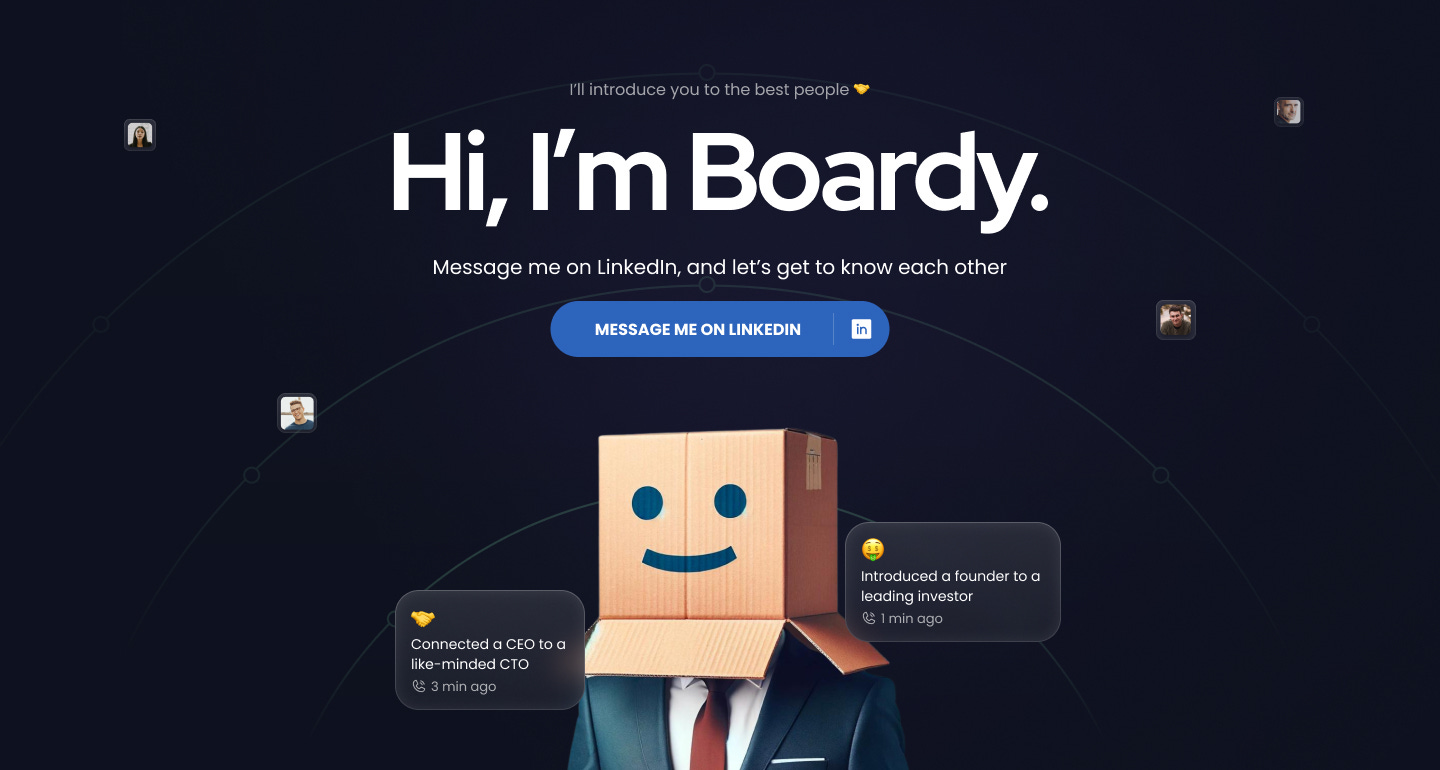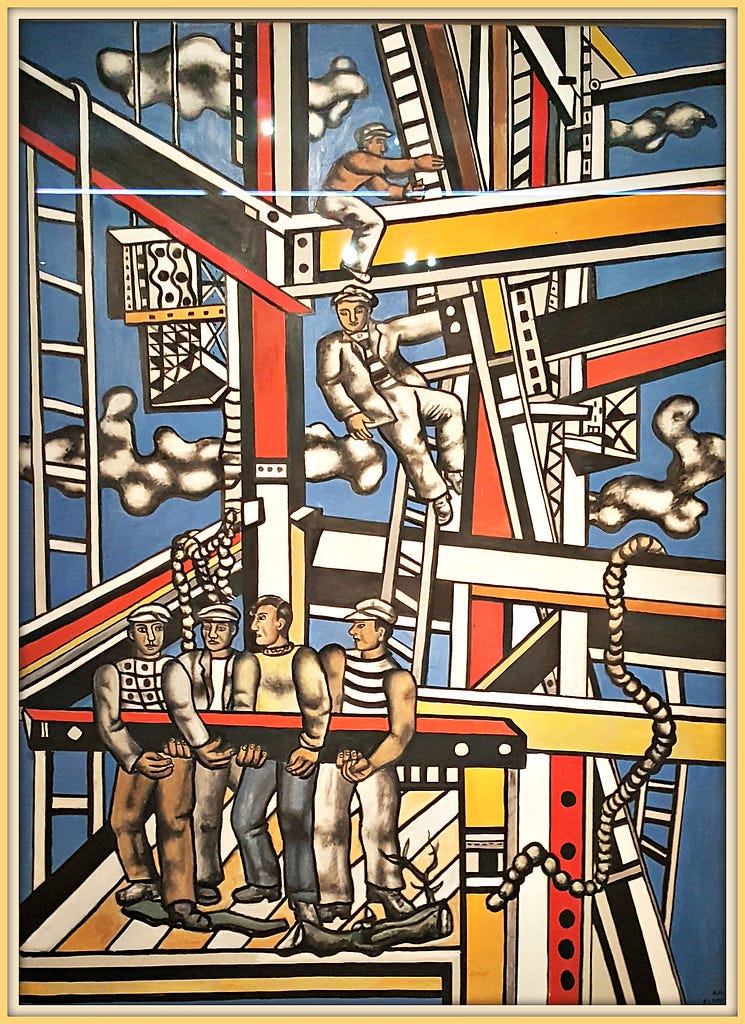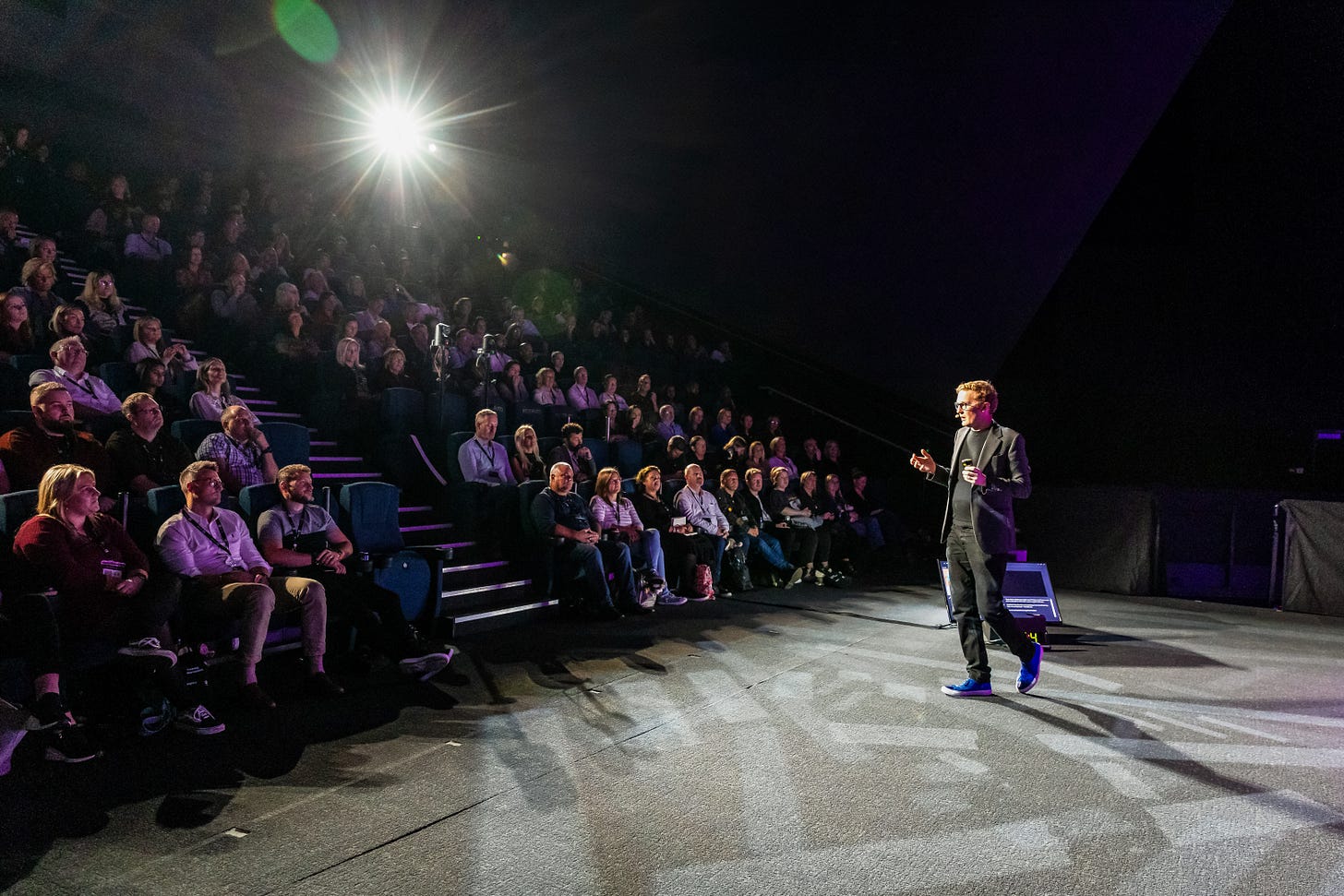DeepSeek, Boardy and AI's non-obvious human future.
⏩ Future Normal: Fast Forward #118
This week, we’re going to dive deep into two AI startups which are not only hot but deeply misunderstood – DeepSeek and Boardy.
In case you’ve been hiding under a rock, DeepSeek is the Chinese upstart that overturned many of the tech industry’s foundational assumptions around AI. I’m not remotely qualified to go into most of these here. So I won’t1.
However, there is one dimension of the DeepSeek story that hugely interests me. And it should interest you because it reveals how AI will reshape innovation, the war for talent and organisational culture, which are topics I’ve spent a long time thinking about ;)
Boardy might be less well-known, but it recently made a splash by raising $8m ‘on its own’. This focus on AI and automation never fails to annoy me, as it steers people away from a far more important use case – how we’ll use AI on a daily basis to fulfil one of our most fundamental human needs, meaningful connection.
Taken together, they offer a vision where humans and AI have a deeply positive coexistence, rather than being in competition.
So strap in – because we’re going to get both practical and deep as we explore:
What’s the future of human talent?
What’s the future of human connection?
What’s the future of humanity?
Okay, I can’t promise all the answers to these questions. But I can promise that you’ll leave with some non-obvious perspectives and actionable insights on the future of innovation, connection, work, and purpose.
Before we get into it: a note from our sponsor (me!).
Many readers here discover me via my keynotes. If you’re lining up your next strategy session, sales kick off, or customer conference – 🚨 I’d love to help.🚨
Typically I inspire clients with:
Your Future Normal: a trend keynote, bringing you non-obvious yet relevant and practical insights from outside your industry.
VisuAIse Futures: anew interactive, ‘multiplayer’ AI-powered creative experience. Watch the 2-min highlight video.
Read more about these at the bottom of this email, or reach out to Renee Strom on renee@ideapress-speakers.com if you’d like to bring me to your next event.
And if I’m not a good fit, then do check out the best speakers I saw in 2024.
What’s the future of human talent in an AI-driven world?
One of the most eye-catching parts of the DeepSeek story was that the Chinese upstart started as a hedge fund’s side project! Which might in and of itself might not be replicable to most readers here. But there’s an even more interesting detail which is relevant to every reader, relating to DeepSeek’s output and its culture – its decision to ‘open source’ its model2.
The idea of ‘giving away’ something so valuable feels jarring to many who came of age in an era dominated by scarcity and ‘rational’ economics. But the AI economy will be fundamentally different. As DeepSeek’s CEO Liang Wenfeng explained:
In disruptive tech, closed-source moats are fleeting. Even OpenAI’s closed-source model can’t prevent others from catching up.
Therefore, our real moat lies in our team’s growth—accumulating know-how, fostering an innovative culture. Open-sourcing and publishing papers don’t result in significant losses. For technologists, being followed is rewarding. Open-source is cultural, not just commercial. Giving back is an honor, and it attracts talent.
…
The most attractive thing for top-tier talent is the opportunity to solve the world’s toughest challenges.
Now this is where I have to blow my own trumpet a little, as this is something that I’ve been talking about for years now (although this is more just a reminder that, despite the screams of hype-merchants in your newsfeed, the firehose of surface-level disruption sits on top of far slower-moving currents).
Indeed, back at the end of 2023 I wrote a whole piece on how AI would unlock a new era of human collaboration:
I’d love for you to read the full piece, but if you’re short on time, then here are a few choice extracts:
At first I imagined [open sourcing] to be a great marketing strategy, but as I’ve tracked examples of other companies doing this over the last five years it’s become clear that there’s another, bigger benefit – ‘giving away’ solutions to systemic problems is an amazing way to attract and retain exceptional talent.
How AI will change the talent equation:
Humans remain profoundly valuable. Indeed a paradox of AI is that, at least until we reach AGI, it is making the most talented humans even more valuable. As we learned last week, Open AI has less than 800 employees working for it. Yet its platform reaches 100 million people each week … In other words, we’re entering a world where less than 800 (eight hundred!) people are building a foundational global utility.
And why these open source initiatives are so important:
I don’t doubt that there are many thoughtful people at Open AI who are working hard to ensure its AI is used for good. Yet no matter how well-meaning they are, it is deeply dystopian for such an elite few to control the means of production. That is why, as Sutskever says, we need more open, collaborative initiatives that help ensure AI delivers benefits to the many, not just the few.
But most importantly, why this is relevant to all companies, and not just deep-pocked, frontier AI labs (whether funded by Google or a hedge fund!):
Many readers will be sitting there thinking, “this is a great strategy for DeepMind, but it is backed by the deep pockets of Google. My company doesn’t have this luxury”. That might be true now.
But AI is radically reducing the ‘cost' of innovation – empowering small, brilliant and hyper-productive teams to move faster and reach further. DeepMind has less than 1/100th of the number of employees that Google has, yet its leveraging AI to transform multiple scientific fields at an astonishing pace.
… and it won’t just be ‘AI companies’ that experience this exponential empowerment. AI is a general purpose technology. What’s happening today within the AI industry will happen tomorrow in your industry.
What was true in 2023, has only become more true in 2025. DeepSeek has less than 200 employees, yet it managed to knock ChatGPT off the top of the App Store and have a trillion dollar market impact!
Back to Liang who, when asked if this belief in open source was ‘madness’, replied:
I’m unsure if it’s madness, but many inexplicable phenomena exist in this world. Take many programmers, for example — they’re passionate contributors to open-source communities. Even after an exhausting day, they still dedicate time to contributing code. It’s like walking 50 kilometers — your body is completely exhausted, but your spirit feels deeply fulfilled.
[Interviewer]: Do you think curiosity-driven madness lasts long-term?
Not everyone can stay passionate their entire life. But most people, in their younger years, can wholeheartedly dedicate themselves to something without any materialistic aims.
Few companies can or would want to accommodate this ‘madness’ across their entire workforce. But in the future normal, they won’t have to.
Great leaders will clear a space for a micro-culture that can attract and harness these ‘mad’ – i.e. ambitious, driven, brilliant – individuals, in order to unleash the exponential impacts that they can generate.
Suddenly, the pursuit of madness becomes the rational choice.
What’s the future of human connection in an AI-driven world?

While the DeepSeek tremors rippled through the markets and across your newsfeeds, I had a moment with AI which was similarly unexpected, similarly unconventional, and perhaps even more brilliantly inspiring.
I had my first successful Boardy call.
Now, if you’re not familiar with Boardy – it’s an AI that aims to mimic a human ‘super connector’. You message it on LinkedIn with your email and phone number, and then a few minutes later, you get a call. From an AI. To discuss what you’re working on, the types of people you’d like to connect with, etc.
As many people have reported, it’s scarily good. Whether it’s the Australian accent, or that you’re mainly talking about yourself (human psychology 101! ;), it’s easy to forget you’re talking to an AI rather than a human.
But the real magic comes next – after your call, you get an email suggesting a potential connection. To be honest, I tried Boardy in November last year and the matches weren’t especially interesting. But I read about it again after it raised $8m3 recently so I thought I’d give it another shot. And it delivered:
Super excited to offer a new introduction for you! Based on my conversation with Mike White, I think you two should meet.
Here are their details: https://www.linkedin.com/in/mike-white-lively
Mike is the CEO of Lively Worldwide and runs Audience101, a subscription community for C-suite marketers, SME founders, and creators. They're pioneering new approaches in experiential and live marketing, having developed innovative models that have transformed how brands connect with audiences. Mike has led global strategy transformations for brands like Ericsson, Twitter, and Coinbase.
Given your expertise in future trends and innovation, particularly your work with AI-enhanced event experiences, I think you'd have a fascinating conversation about the future of audience engagement and live experiences. Mike is also building an "always-on" conference and is specifically looking for thought leaders who can speak about the intersection of technology, media, and audience behavior – right up your alley!
You can respond simply with a 'yes' or 'no', and if you're available to meet I'd be happy to introduce you both!
Now my mind was blown. This truly felt like an introduction that you’d get from a trusted friend. Mike must have also replied yes, because after our double opt-in, we were connected (I’ve asked his permission to share this story).
It felt like the early days of online dating. As we scheduled a 30-minute call, both of us were wondering “is this going to be weird?” 75 minutes later, we had our answer…
Now, whether this interaction turns into a longer professional relationship, it’s too soon to tell (although shamelessly – Mike, I hope we can make at least one of our ideas land!). But that’s not why I’m sharing this heart-warming tale.
I’m sharing it to inspire you to:
Go try it for yourself! It was a bit of a leap of faith to share my number with an unknown AI (you message Boardy on LinkedIn). But it’s a fascinating and yet deeply accessible experience that’s worth having to remind you of what lies beyond ChatGPT, as voice and video open up new possibilities4.
Ask what wholly new solutions AI will unlock, rather than just a faster / cheaper way of doing today’s work. Boardy is also a great example of an AI-native approach to solving a well-known problem. Personalised, relevant 1:1 intros are clearly hugely desirable. They’ve just been impossible to automate. Until now.
Aaron Levie, CEO of Box, has written compellingly that the real impact of AI will be on “bringing automation to is the work that we just never got around to in the first place … [to] attack the kinds of problems that just never were economically feasible to solve before.”
Think how to use AI to create ‘better’ human-human connections. My starting point when thinking about the future, even before asking “what’s changing?”, is always to ask “what won’t change?”
It is obvious that as we experience a greater number of interactions with AI, we’ll find even greater value in authentic human connections. It is non-obvious that AI will be the route to improved human connection. But it will.
In The Weird World of Working With AI Agents, I quoted Seth Godin at length:
Most visions of the internet in 1995 were about individuals interacting with content online. It turns out that the internet is actually about connection. The apps and businesses that were most successful connected people–to ideas, to things or mostly, to each other.
The current range of AI feels like content creation. You can have an AI write your high school essay, draw you a picture or invent a recipe. But perhaps history will repeat itself. Perhaps developers will realize that persistent knowledge of what came before and who needs help and connection is the next frontier.
So… what happens when the AI in our lives begins acting like a thoughtful, patient and trusted friend? Not just like the AI in the movie Her, but more focused on our networks and connections. Who’s trustworthy, talented, available or in need… It knows what’s happening now, but also what happened yesterday. Not just to us, but to those in our circle and the people they know as well…
I hadn’t heard of Boardy when I wrote that piece. But it has shown me one compelling way that more natural interactions with AI can create genuine, relevant human connections – and it won’t stop at networking. Indeed, I’m sure your brain is already overflowing with possibilities.
In the past two weeks, I’ve presented this to various clients, leading to discussions around how a Boardy-for-Sales could revolutionise the B2B enterprise sales funnel; with a legal firm how it could transform client qualification, onboarding, and matching clients to individual lawyers; and with a hotel management team how this could offer more intuitive and convenient ways to tailor guest experiences and source feedback.
Human connection is, and will remain, the lifeblood of most businesses. So instead of thinking about replacing people, how will you use AI to bring people closer together?
What’s the future of humanity in an AI-driven world?
We’ve looked at what DeepSeek tells us about the future of talent. We’ve looked at what Boardy tells us about the future of connection. For many readers, that’s already more than enough to digest. And if you’re exclusively looking for insights to run with in 2025, then you can probably stop reading now.
But if you want to push on into thinking more philosophically about how these signals will converge and shape humanity’s sense of identity – then you’ll enjoy this final section. 😇
Full disclosure: this part is heavily inspired by my friend Evgeny Shadchnev’s brilliant piece Being Human in the Age of AI. It’s well worth reading the whole piece, but to paraphrase, he asks whether AI will have similar effects on our perception and valuation of intelligence as the Industrial Revolution did for strength.
We now look back, with pity, at how basic we were in pre-industrial times – when physical strength was an economic asset and therefore a source of social status and identity.
Will the next generation look back at our era similarly – marvelling, in horror, at how we placed such value on intelligence, an attribute that obviously should be left to far more capable algorithms?
Will we care that (most) people no longer leverage their intelligence, if this liberates us to focus on more enlightened, human qualities – such as love, art, creativity, teaching, respect, fun, and connection?
I warned you at the start I wouldn’t have all the answers. However, given all the dystopian narratives around AI it’s important we ask, “what if things go right?”
DeepSeek and Boardy may be weak signals but they show us a future normal where organisations win because they have cultures that attract people, and products that connect them.
As always, this is far from certain – but it feels like a not unrealistic, and yet profoundly optimistic vision of how ever-more intelligent AI systems can work for us, not against us.
Which leads me onto my final question – how will you make this future normal a reality?
Next: bring these insights to your team
In 2024 I delivered 30+ sessions, both live and virtually – from Brazil to Saudi Arabia, Las Vegas to London.
My regular trend & innovation keynotes bring fresh, cross-industry, people-first perspectives to your audience.
VisuAIse Futures takes it one step further, turning a keynote into an interactive, ‘multiplayer’ creative experience that leaves teams excited at how how AI will invigorate their innovation culture.
Here’s what people are saying about it:
“It was so refreshing to hear how AI can be used to power human imagination, rather than replace it. And then it was even better to actually experience it”
“Fantastic session! Hugely insightful and fun, too!”
“Brilliant. The feeling in the room was positively intense whilst the images were coming through!
Feel the optimistic vibes it will bring to your event in the 2-minute video below (or watch it here).
If you’d like to discuss bringing me to your next meeting or event then please do reach out directly to Renee Strom or check out my speaking site.
Thanks for reading,
Henry
If you want a primer on these, then check out this Perplexity summary (using a US-hosted R1 model), or ChatGPT’s o3-mini-high version. Or, if you prefer an AI-augmented human analysis, then Azeem Azhar has two excellent pieces here and here.
There’s some debate about whether (like most AI models), DeepSeek’s R1 models can truly be called ‘open source’, under the technical software definition. I’m unapologetically using the term loosely.
I have no financial interest in Boardy. I simply think it’s worth talking about as represents many important trends.
I should also flag that Boardy also experienced backlash over a tone deaf email campaign it sent, ‘roasting’ users’ LinkedIn profile pictures. This was a human-created campaign, but we turn to AI to augment human relationships it will be critical to consider – and expose – how these AIs process people’s data and how they make their decisions.







This was awesome! Just did the Boardy thing. Aussie voice was terrific. Now waiting for email intro followup.